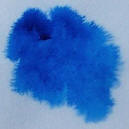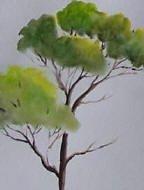|
Ink and it's use.
Ink comes to us in various types, with
different qualities from numerous manufacturers. When you are faced with
them all in an art shop or pictures at an online shop, choosing the
right one can be very daunting, especially for those taking their first
steps into pen work or calligraphy. Most inks will work in either
situation, but the type of ink can make the difference between, a happy
result and one that ends up in the bin!
Ink has properties;
these properties often affect the resultant finish to the work. If we
look at these properties and know what they mean to us and our work, it
will help in choosing the ink.
Waterproof and
non-waterproof.
Whether an ink is
waterproof or not makes a difference to the type of pen you can use; how
you clean your pen and if the surface of your work is to be wetted.
Most pens and nibs will work successfully with non-waterproof ink, it's
easy to clean the pen and mostly used for letter writing, calligraphy
and some finished drawing work that will be protected by glass.
Pelikan
4001 and Classical Transparent would fall into this category.
 Waterproof ink
on the other hand it not recommended for fountain pens and most
technical pens, but dip pens, quill, brush and ruling pens are ideal.
The ink is waterproof when dry therefore perfect for 'pen and wash' or
where the surface is to we wetted, cleaning is not always as simple as
washing the nib under the tap, as ink allowed to dry on the nib can be
quite difficult to remove.
Drawing Ink A,
Indian Ink and Permanent Pigmented Ink would fall into this category. Waterproof ink
on the other hand it not recommended for fountain pens and most
technical pens, but dip pens, quill, brush and ruling pens are ideal.
The ink is waterproof when dry therefore perfect for 'pen and wash' or
where the surface is to we wetted, cleaning is not always as simple as
washing the nib under the tap, as ink allowed to dry on the nib can be
quite difficult to remove.
Drawing Ink A,
Indian Ink and Permanent Pigmented Ink would fall into this category.
Lightfast-ness
also referred to as Permanence (durability).
The pigment or dye
that the ink is made from, usually has a tested lightfast quality, this
indicates if it will fade or not when in daylight conditions.
Lightfast-ness tends to be expressed as excellent; very good; good etc.
Permanence is usually expressed as permanent; semi-permanent etc. Ink
with a poor lightfast/permanence quality will fade/loose its colour
quickly over time. It's also best not to keep ink work in sunlight or
very bright daylight conditions. Dye based inks, mainly for fountain
pens, are not usually as lightfast as pigment inks. Pigmented inks are
usually lightfast and not for use with fountain pens.
Permanence can also
be used in a different context - as in 'permanent marker (immovability)'
in this instance it refers to the fact that the ink is permanent when
dry and will not rub off when applied, this is not it's lightfast-ness,
because this ink may fade quickly over time. You will need to read the
write up on the ink to establish the makers meaning of permanence.
pH
(acidity/alkalinity)
For your ink work to
have archival qualities, you need - as near as possible, pH neutral ink.
The range classed as pH neutral for ink is, up to 8.0 - 8.5 and down to
6.0 -5.5 where Ph neutral is 7.00. Most inks today are made within this
range, but some inks made from historical formulas are very acidic and
can 'over time' eat/burn through the paper and leave holes where the
writing once was!
Flow.
Ink needs to flow
from the nib or instrument. There are no hard and fast rules about the
flow of the ink, but as a general guide - transparent ink flows faster
from the nib then opaque ink. Many inks need stirring because over time
the pigment settles to the bottom of the bottle, these are often slower
flowing inks. Stirring is the preferred method, as shaking the bottle
can produce copious bubbles which makes the ink difficult to work with.
Dried ink on the nib or reservoir of dip pen nibs will slow the flow;
you may also need to wipe the nib often when using faster drying inks.
Having decided what
you are using the ink for -
pen and wash, drawing, writing or
calligraphy. You then need to decide if it is to be waterproof or
non-waterproof, if non-waterproof then most pens will work with the ink.
If it is to be waterproof then pens other than a fountain pen would be
the choice, although some technical pens cannot be used for waterproof
ink. It's best to check the makers instructions.
When loading dip
pens, a more accurate way than dipping in the bottle, is to load the ink
via a dropper or paint brush into the reservoir. If it doesn't have a
reservoir then you may feel the need to dip the pen and wipe off the
excess, but you can still load it with a paint brush.
Having loaded the
reservoir, test that the ink is flowing from the nib on a spare piece of
paper, the same as the type you are using, the ink needs to flow giving
clean, crisp lines.

If you have trouble
getting the ink to flow try some of the following; some people wiggle
the nib from side to side; you can put a drop of ink onto paper and draw
the nib through it; my preferred method is to have a damp piece of paper
or kitchen towel and draw the nib gently across it, this works nine
times out of ten and doesn't strain the nib tines.
Ink has many
applications and is well worth the time invested in appreciating it's
properties and potential. I hope this small introduction gives those new
to ink a start in the right direction.
Copyright 2006
Jacqui Blackman
Fountain
pen ink
Sepia ink
Drawing ink
Drawing ink A
Waterproof ink
Ink Selection
Copyright Jacqui Blackman 2005 
|